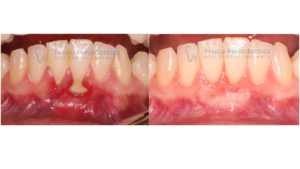 Most people are used to basic cleanings and maybe the regular fluoride treatment when they visit the dentist. But gum grafts don’t get nearly as much attention. If you’re not familiar with gum grafts or what they’re for, that’s okay. A periodontist can break down exactly what they are for and how to determine if you need a gum graft in Frisco. They have the ability to improve the appearance of your smile and restore it, especially if you struggle with tooth sensitivity.
Most people are used to basic cleanings and maybe the regular fluoride treatment when they visit the dentist. But gum grafts don’t get nearly as much attention. If you’re not familiar with gum grafts or what they’re for, that’s okay. A periodontist can break down exactly what they are for and how to determine if you need a gum graft in Frisco. They have the ability to improve the appearance of your smile and restore it, especially if you struggle with tooth sensitivity.
Do You Need a Gum Graft?
If your gums are receding from your teeth, a gum graft surgery may be the best solution. When the gums recede, the roots become exposed as tissue slowly pulls away. By having a gum graft, the periodontist can stop this progression in its tracks and avoid many dental issues, including tooth decay and loss as well as bone loss. Gum grafts also protects your mouth overall and reduce sensitivity, a common symptom associated with receding gums. If you regularly eat hot or cold foods and beverages, you’ll likely notice a difference after the gums have fully healed. Even if you don’t have sensitivity or exposed roots, gum grafts can also be performed for cosmetic purposes.
But how do gums recede in the first place? The most common cause is gum disease caused by improper oral hygiene/lack of professional dental care. Excessive brushing at the gum line can lead to thinning and erosion of the gums. But they can also recede due to poor life choices (cigarette smoking and smokeless tobacco), fluctuation of hormones during pregnancy, genetics, and other causes. By committing to regular oral care and avoiding tobacco products, you can dramatically reduce your risk of gum disease.
What is a Gum Graft?
Gum grafting is a procedure designed to thicken the gums with the intentions of covering the roots within reason. This procedure is performed by taking healthy gum tissue from other areas of your mouth and applying it to the roots of your teeth. The tissue is typically taken from the palate and applied to one or more teeth at a time, depending on the condition of you gums.
There are different kinds of gum grafts that periodontists perform. The most common of these procedures is a connective-tissue graft. This method utilizes connective tissue from underneath the skin on the roof of the mouth. Alternatively, periodontists can perform either a gingival graft or a pedicle graft. Gingival grafts take the skin tissue from the palate and pedicle grafts simply rotate adjacent gum tissue from its adjacent tooth. The periodontist can also utilize a tissue bank and/or growth factors/stem cells to promote the natural regrowth of gum tissue.
The Gum Graft Procedure
While gum grafting is not a very significant procedure, it should be noted that patients typically feel some discomfort afterwards. If you opt for sedation during your treatment, it can help you stay more relaxed during and after completion, depending on the option you choose.
In conclusion, the best first step you should take is to speak with a board certified periodontist. They can answer any questions, provide the positives and negatives of pursuing treatment in your case, and possibly other alternatives if you are not a candidate or hesitant to utilize your own gum tissue. Have more questions about gum grafts? Schedule a consultation with a periodontist in Frisco today!
About the Author
Dr. Zachary Carnow has treated many patients with a wide variety of periodontal conditions. He always makes sure to take his patients’ oral health and appearance into account when performing all periodontal therapies, including gum grafts. To learn more about treatment or see if it’s right for you, you can contact him through his website.
